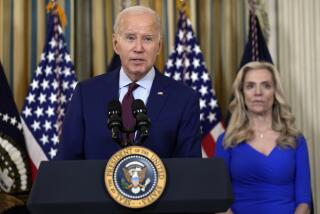Obama administration proposes tighter regulation of derivatives
- Share via
WASHINGTON — The Obama administration Wednesday proposed a broad new framework for regulating the dark and complex world of over-the-counter derivatives, vowing to shine a light on the financial products behind the downfall of insurance giant American International Group Inc.
“There is widespread agreement that . . . derivatives, particularly credit default swaps, may have contributed greatly to the financial mess that we’re cleaning up now,” said Mary Schapiro, chairwoman of the Securities and Exchange Commission.
“Unfortunately, the lack of clear regulatory authority over this vast market has hindered the ability of regulators to fully understand how the market functions or to insure that basic standards of fairness are followed,” she said. “There is full agreement now that this needs to change.”
AIG had such a huge financial exposure to derivatives, especially credit default swaps, that eventual losses turned the global insurer into the single biggest basket case in the nation’s financial bailout, with federal commitments for $182.5 billion in aid.
The International Swaps and Derivatives Assn., an industry trade group, estimated that there was about $403 trillion in outstanding derivatives at the end of last year, with credit default swaps making up about $38.6 trillion of that.
Credit default swaps are, in essence, insurance policies. AIG issued them to banks and other major institutions to cover potential losses on mortgage loans and other investments.
Because so little was known about the derivatives market, regulators were unable to foresee the problems that triggered the financial crisis last year, and holders of those derivatives panicked out of fear that they would not be paid.
The administration’s plan would set new rules for all standardized derivatives, requiring their trades to go through regulated central counter-parties, or middlemen. All major derivatives dealers also would be subject to supervision and regulation, including reporting requirements and minimum levels of capital on hand. And trades of customized derivatives would have to be reported to regulated trade repositories that would make some aggregated data, such as trading volumes and open positions, available to the public.
Oversight would be shared by the SEC and the Commodity Futures Trading Commission, which would have increased powers to monitor the markets for fraud, abuses and signs of risk to the overall financial system. Congress must change some laws and enact new ones to allow more derivatives regulation.
Treasury Secretary Timothy F. Geithner wrote to key congressional leaders Wednesday detailing the changes and urging action. The proposal builds on the regulatory reform Geithner unveiled in March, but many key details still were missing.
Geithner said he had four objectives for regulating derivatives: prevent them from causing “systemic risk” to the financial system; provide more efficiency and transparency to the market; prevent fraud and abuse; and make sure that dealers don’t market the products to less-sophisticated investors. Some small municipalities have lost millions of dollars because of derivatives.
Joel Telpner, a derivatives expert with law firm Mayer Brown in New York, called the administration’s proposed framework a “measured and appropriate response.”
“It creates an ability to provide much greater transparency than we have had in the past, which would alleviate fears and give regulators the tools to head off potential problems in the future,” he said.
Robert Pickel, executive director of the derivatives trade group, said the group welcomed the plan and would work with lawmakers and regulators to “ensure these reforms help preserve the widespread availability of swaps and other important risk-management tools.”
--
More to Read
Inside the business of entertainment
The Wide Shot brings you news, analysis and insights on everything from streaming wars to production — and what it all means for the future.
You may occasionally receive promotional content from the Los Angeles Times.











